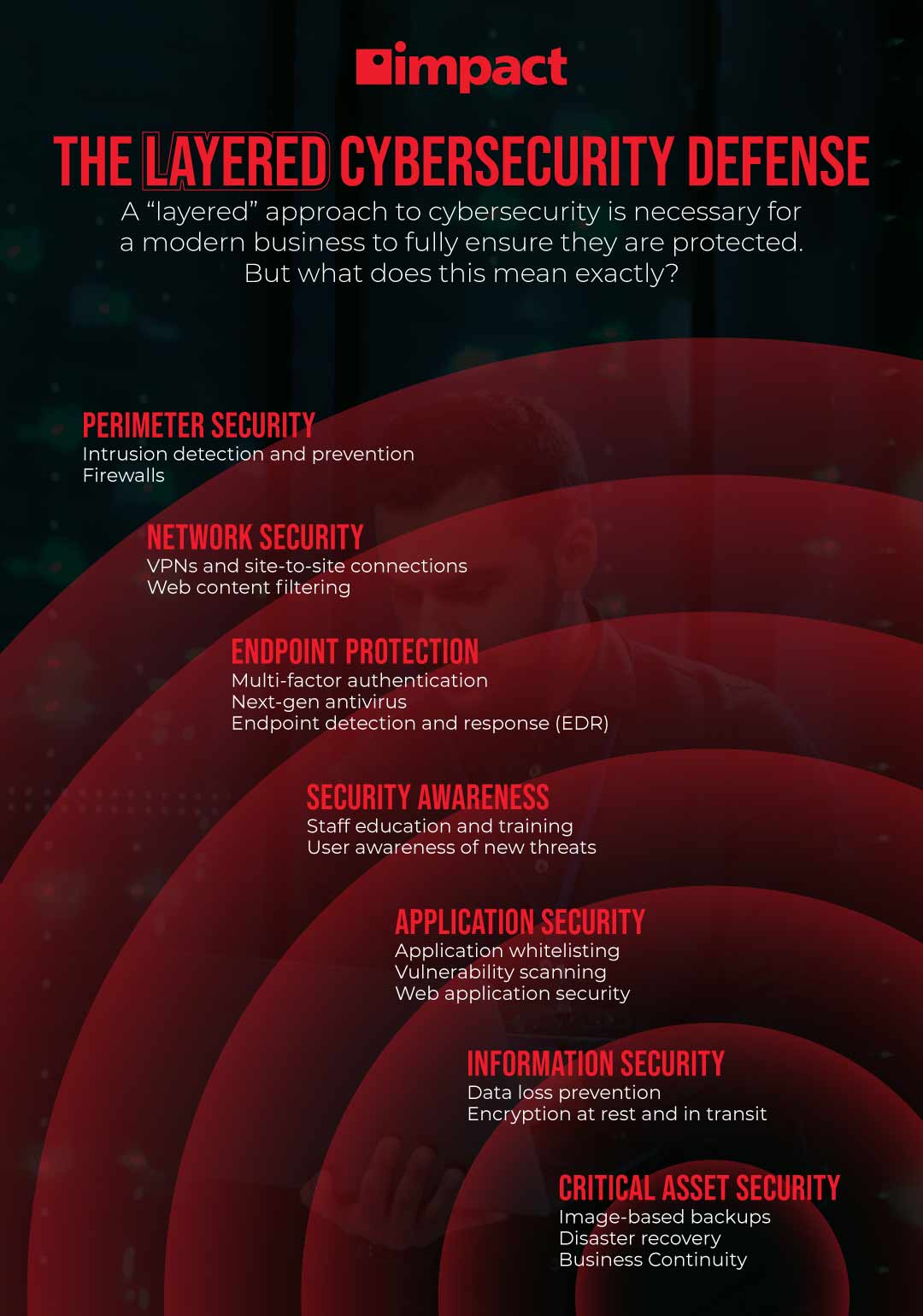Even if you have the best prevention tools, what happens when an attack still manages to get through your defenses and into your business’ network? That’s where threat detection comes into play to help you identify, eliminate, and recover from cyberattacks that find their way into your network.
Threat Detection’s Place in a Layered Cybersecurity Approach
A layered cybersecurity approach is when businesses utilize several different cybersecurity initiatives together to form one larger, cohesive strategy. Each aspect of that strategy is backed up by another to form "layers" of defense.
The layers, as commonly known, include:
- Perimeter Security: Firewalls, antivirus software, and other tools that prevent threats from getting into a business network.
- Network Security: VPNs, site-to-site connection, and web filtering to help secure network connections.
- Endpoint Protection: Cybersecurity protocols designed to protect the devices commonly used by users to access data, information, and the network in general.
- Security Awareness: Also known as the ‘human layer,’ this involves training, education, and general awareness by users throughout a company.
- Application Security: Scanning for vulnerabilities in third-party applications and websites.
- Information Security: Preventing data loss by securing critical information while being stored and when being shared using encryption techniques.
- Critical Asset Security: Backing up business-critical data for business continuity after a breach.
Each layer is just as important as the one above and beneath it, but businesses tend to shift their focus more toward prevention (training, antivirus software, firewalls, encryption, etc.) and often forget the importance of having a strong alert system, aka threat detection, to show them when a bad actor has penetrated the network.
After all, you can have the world’s greatest home security system, but if you focus so much on keeping people out, you may not notice when they actually get in without having those systems in place, too.
What is Threat Detection in Cybersecurity?
Threat detection is one of the most important parts of a business’ cybersecurity strategy because it allows you to quickly identify when your network has been compromised by intruders. Without proper threat detection, cybercriminals could access your network and stay there for unknown amounts of time, leaving traps, stealing data, and gathering intel for future attacks.
Unfortunately, in modern business, it’s impossible to deter every single attack that comes your way. Cybercriminals are smart, relentless, and adaptable. An attack that penetrates your defenses is inevitable, that’s why it’s critical that businesses spend as much time considering what happens after an attack as they spend trying to prevent them.
Without threat detection, and a recovery plan, you are at the whim of the attacker who essentially has a full run of your network because you don’t know that they’re there and you have no set plan of action to stop them and begin recovering.
What Tools, Processes, and Protocols Make Up Threat Detection?
To detect threats that make it past your externally-facing defenses, cybersecurity experts and analysts use tools with different forms of detection to home in on different kinds of attacks and attack vectors. Here’s a quick rundown of four different detection techniques, what they do, and what attacks they’re used to identify:
Behavior-Based Detection: This detection technique uses behavioral trends tracked over time to help identify abnormalities. It works by tracking digital patterns in behavior (user activity, network behavior, etc.) to determine standard/good behavior and abnormal/bad behavior to find potential threats. This is often used to detect insider threats (though it is used to find external threats, too) such as certain users accessing more data than usual or accessing data they don’t normally use.
Statistics-Based Detection: This technique measures numbers to detect a baseline, variations in that baseline, as well as outliers to find anomalies and potential attacks. This is especially useful in weeding out machine-lead attacks like brute forces.
Algorithm-Based Detection: This technique uses machine learning and AI to predict and identify attacks based on data collected within a system and the typical callsigns of an attack. An algorithm sorts through data and sees attack potential and identifies anomalies based on that information.
Signature-Based Detection: A signature-based detection method looks for attributes of known malicious attacks (malware, ransomware, etc.) to identify those not blocked or filtered out by firewalls or antivirus software.
Life Without Threat Detection for Businesses
Without proper threat detection tools in place, there can be major negative side effects for businesses. Letting cybercriminals roam freely throughout your business network can bring forth large detriments to business operations, data security, privacy, and more. In simple terms, criminals will find a way to beat your defenses at some point and if you don’t have threat detection and response plans in place, you may not know about those attacks until it’s too late.
Undetected malware can sit dormant for a long time, slowly gathering data, stealing information, and analyzing your network. This gives cybercriminals more time to understand your defenses and prepare for a larger attack. Additionally, long-term data theft can harm your business, your customers, and your employees, and bring about large fines if found non-compliant with certain security regulations.
The longer an attack goes without being discovered and responded to, the more expensive it tends to be for businesses to fully recover if they can at all.
What Happens After a Threat is Detected?
After a breach or attack is detected, a business’ disaster recovery plan goes into effect.
Related: Disaster Recovery Plan Steps to Protect Your Business
A disaster recovery plan involves a series of steps to ensure business information and assets critical to operations are protected, backed up, and restored quickly to avoid prolonged downtime. Additionally, this plan involves developing organizational roles and responsibilities for who handles what during recovery, as well as evaluating disaster scenarios to ensure everyone is prepared and knows what to do next.
How Can Businesses Implement Threat Detection?
Implementing threat detection tools into your business can be a big lift, especially if you have a small or inexperienced IT or cybersecurity team. It involves a lot of training, testing, and monitoring to ensure that you’re making the most of the technology and that it’s working appropriately to continue identifying changing threats.
To help, it’s sometimes a good idea to partner with a managed security services provider to give your business the tools, expertise, and time that it takes to successfully implement and operate these tools.
Threat Detection as One Piece of the Puzzle
It’s also important to remember that threat detection is just one part of a layered cybersecurity approach that covers all angles from education to prevention to detection and recovery.
Learn more about what a full-fledged layered security approach means for your business and how you can achieve it to stay secure against modern threats with our eBook, What Makes a Good Cybersecurity Defense for a Modern SMB?


